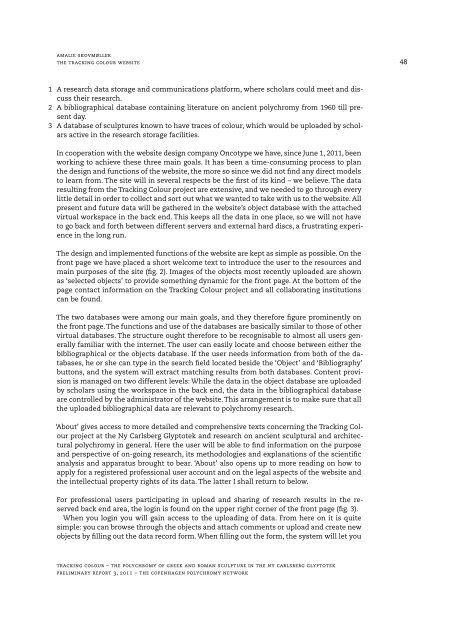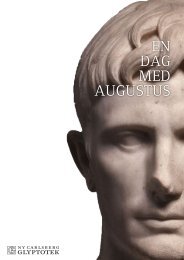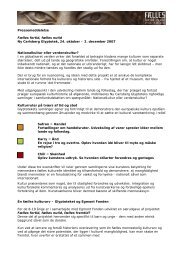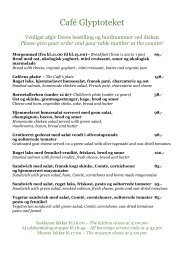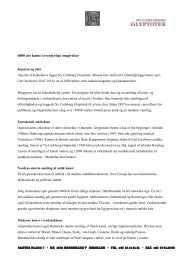Preliminary Report 3, 2011 - Ny Carlsberg Glyptotek
Preliminary Report 3, 2011 - Ny Carlsberg Glyptotek
Preliminary Report 3, 2011 - Ny Carlsberg Glyptotek
You also want an ePaper? Increase the reach of your titles
YUMPU automatically turns print PDFs into web optimized ePapers that Google loves.
Amalie Skovmøller<br />
The Tracking Colour Website<br />
48<br />
1 A research data storage and communications platform, where scholars could meet and discuss<br />
their research.<br />
2 A bibliographical database containing literature on ancient polychromy from 1960 till present<br />
day.<br />
3 A database of sculptures known to have traces of colour, which would be uploaded by scholars<br />
active in the research storage facilities.<br />
In cooperation with the website design company Oncotype we have, since June 1, <strong>2011</strong>, been<br />
working to achieve these three main goals. It has been a time-consuming process to plan<br />
the design and functions of the website, the more so since we did not find any direct models<br />
to learn from. The site will in several respects be the first of its kind – we believe. The data<br />
resulting from the Tracking Colour project are extensive, and we needed to go through every<br />
little detail in order to collect and sort out what we wanted to take with us to the website. All<br />
present and future data will be gathered in the website’s object database with the attached<br />
virtual workspace in the back end. This keeps all the data in one place, so we will not have<br />
to go back and forth between different servers and external hard discs, a frustrating experience<br />
in the long run.<br />
The design and implemented functions of the website are kept as simple as possible. On the<br />
front page we have placed a short welcome text to introduce the user to the resources and<br />
main purposes of the site (fig. 2). Images of the objects most recently uploaded are shown<br />
as ‘selected objects’ to provide something dynamic for the front page. At the bottom of the<br />
page contact information on the Tracking Colour project and all collaborating institutions<br />
can be found.<br />
The two databases were among our main goals, and they therefore figure prominently on<br />
the front page. The functions and use of the databases are basically similar to those of other<br />
virtual databases. The structure ought therefore to be recognisable to almost all users generally<br />
familiar with the internet. The user can easily locate and choose between either the<br />
bibliographical or the objects database. If the user needs information from both of the databases,<br />
he or she can type in the search field located beside the ‘Object’ and ‘Bibliography’<br />
buttons, and the system will extract matching results from both databases. Content provision<br />
is managed on two different levels: While the data in the object database are uploaded<br />
by scholars using the workspace in the back end, the data in the bibliographical database<br />
are controlled by the administrator of the website. This arrangement is to make sure that all<br />
the uploaded bibliographical data are relevant to polychromy research.<br />
‘About’ gives access to more detailed and comprehensive texts concerning the Tracking Colour<br />
project at the <strong>Ny</strong> <strong>Carlsberg</strong> <strong>Glyptotek</strong> and research on ancient sculptural and architectural<br />
polychromy in general. Here the user will be able to find information on the purpose<br />
and perspective of on-going research, its methodologies and explanations of the scientific<br />
analysis and apparatus brought to bear. ‘About’ also opens up to more reading on how to<br />
apply for a registered professional user account and on the legal aspects of the website and<br />
the intellectual property rights of its data. The latter I shall return to below.<br />
For professional users participating in upload and sharing of research results in the reserved<br />
back end area, the login is found on the upper right corner of the front page (fig. 3).<br />
When you login you will gain access to the uploading of data. From here on it is quite<br />
simple: you can browse through the objects and attach comments or upload and create new<br />
objects by filling out the data record form. When filling out the form, the system will let you<br />
tracking colour – The polychromy of Greek and Roman sculpture in the <strong>Ny</strong> <strong>Carlsberg</strong> <strong>Glyptotek</strong><br />
<strong>Preliminary</strong> <strong>Report</strong> 3, <strong>2011</strong> – the copenhagen polychromy network


